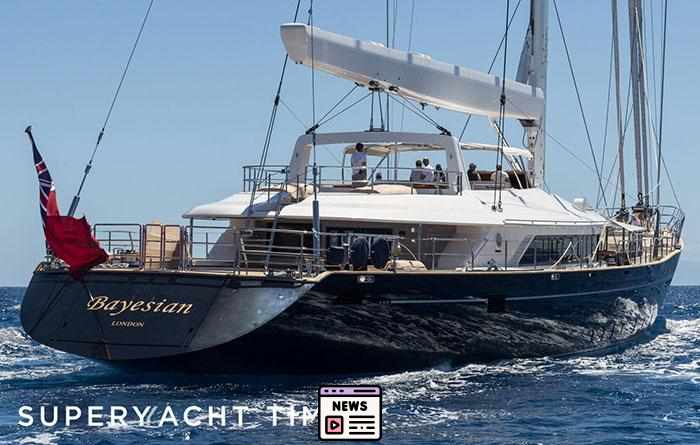Updated on: October 8, 2024 9:01 am GMT
In a harrowing maritime tragedy, preliminary autopsy results reveal that four of the six individuals who perished when the luxury superyacht Bayesian sank near Sicily on August 19 died from suffocation, rather than drowning. The incident claimed the lives of British tech entrepreneur Mike Lynch, his daughter Hannah, and four others, including Jonathan Bloomer, the chairman of Morgan Stanley International, and his wife, Judy. The yacht sank abruptly during a storm in the waters off Palermo, leaving survivors and investigators grappling with the implications of this maritime disaster.
Details of the Incident
The Bayesian, a 56-meter yacht owned by Lynch, sank suddenly during a violent storm while on its way along the coast of Sicily. Lynch, recently acquitted of fraud charges in the United States, was reportedly on a family trip with his daughter and several family friends. Among the deceased were Bloomer, his wife, and law partners Chris Morvillo and Neda Morvillo, all recognized figures in the finance and legal sectors.
Reports from the scene indicate that the victims were found in a cabin that likely became an air pocket as the vessel tilted, leading to a severe depletion of breathable air. Preliminary autopsy findings suggest that the victims suffered from lack of oxygen, and notably, there were no indications of water in their lungs, pointing away from drowning as the cause of death.
Recovery Efforts and Investigations
Rescue divers from the Italian coast guard have been meticulously recovering bodies from the wreck site. Efforts to gather the remaining deceased include ongoing forensic examinations, with additional autopsies scheduled for later this week. The discovered victims were situated in a compartment on the left side of the boat, which supposedly indicates they were searching for remaining air as the yacht rolled.
Mike Lynch’s 18-year-old daughter, Hannah Lynch, was one of the last bodies recovered, and further autopsy results are expected over the coming days. In total, the tragedy resulted in the loss of six lives, including the yacht’s chef, Recaldo Thomas.
The Investigation into Alleged Negligence
The situation surrounding the sinking of the Bayesian has prompted an investigation by Italian authorities, focusing on potential negligence linked to the yacht’s crew. Captain James Cutfield, alongside crew members Tim Parker Eaton and Matthew Griffiths, have all been placed under investigation for possible manslaughter. However, it is essential to note that being under investigation does not imply guilt or an inevitable move toward formal charges.
Reports suggest that investigators are reviewing the possibility that negligence, such as failure to secure external doors during severe weather, may have contributed to the rapid sinking of the yacht. The inquiry will scrutinize emergency protocols and the actions taken by the crew during the critical moments of the storm.
Public Reaction and Ongoing Inquiry
The incident has not only stunned the families involved but has also captured public attention due to its unusual circumstances. Experts in maritime safety and related fields have expressed their astonishment that a vessel of this size and caliber, built by renowned shipbuilder Perini, could sink so rapidly. The incident brings to the fore discussions about safety protocols aboard luxury vessels, particularly during adverse weather conditions.
As the investigation continues, maritime specialists and observers remain watchful for further findings that may elucidate what transpired during those dire moments at sea. The Bayesian’s wreckage is slated to be salvaged as part of the investigative process, potentially revealing more information about the disaster.
Context of Maritime Safety
This incident highlights ongoing concerns around maritime safety and the protocols that vessels should adhere to, particularly in severe weather conditions. The use of terms like “dry drowning” by some media outlets has been met with criticism, as medical professionals argue that such terms lack proper definitions and may not accurately describe the physiological processes leading to asphyxiation without immersion.
According to the American Red Cross, the terminology surrounding non-drowning asphyxiation lacks scientific basis, further complicating public understanding of drowning and near-drowning incidents. Such discourse shows the importance of accurate language in addressing and educating the public about occupational and recreational water safety.
Looking Ahead
While the investigation unfolds and families mourn their losses, the tragedy of the Bayesian serves as a sobering reminder about the unpredictability of nature and the critical importance of adhering to safety measures at sea. As legal and maritime communities seek to address potential pitfalls revealed by this incident, it may prompt broader discussions about reforms in the yachting industry, emphasizing the necessity for stringent safety regulations.
The investigation will find out who is responsible and help make sea travel safer for everyone. This could stop future accidents and give people more confidence when they go out on the water.
